With the departure of Christian Pulisic to Chelsea, it's likely many think the American presence in the Bundesliga has waned. While the Hershey, Pennsylvania native’s move to Chelsea probably caused a headache or two in US TV executive rooms, in terms of depth, the American contingent has never been stronger. In the last few seasons, the infusion of another batch of young American talent ( including the likes of Weston McKennie, Josh Sargent and Tyler Adams) there are now a record-setting 13 Yanks in Germany, 8 of whom have completed at least ten games. With apologies to the rejuvenated Timmy Chandler and other usual suspects such as John Brooks and Alfredo Morales, here we're taking a look at four young Americans you may not have heard much about who are getting their feet wet in Germany’s top division.
Zack Steffen
Zack Steffen, who despite missing the last three matches with a knee injury, has been a roaring success between the sticks. The 24-year-old’s Fortuna Düsseldorf season began with ten saves on his debut in a stunning win against Werder Bremen, one of the highlights of a dismal campaign. The Manchester City loanee was among the top three keepers early on in the season. Steffen regularly faced 5–6 shots on target per match and had multiple nine-save matches in the first six rounds, but like his team, his goals saved above average began to drop; it is now -1.66. That figure is in large part a byproduct of a team with a -17.6 expected goal difference, by far the worse in the Bundesliga. So while Steffen might seem to be performing slightly worse than an average keeper, he's doing it in a context where the ten players in front of him are all significantly worse than that. Looking at his map, you can see the barrage of close-range, high xG value goals conceded. The post-shot xG of the shots on target he's faced is 0.36, tied for 2nd behind poor Roman Bürki. Video review also shows a couple strange low-quality chances scored against Steffen, which drags down his shot-stopping numbers (flukes happen, but you don't get to only count the good stuff in the averages). 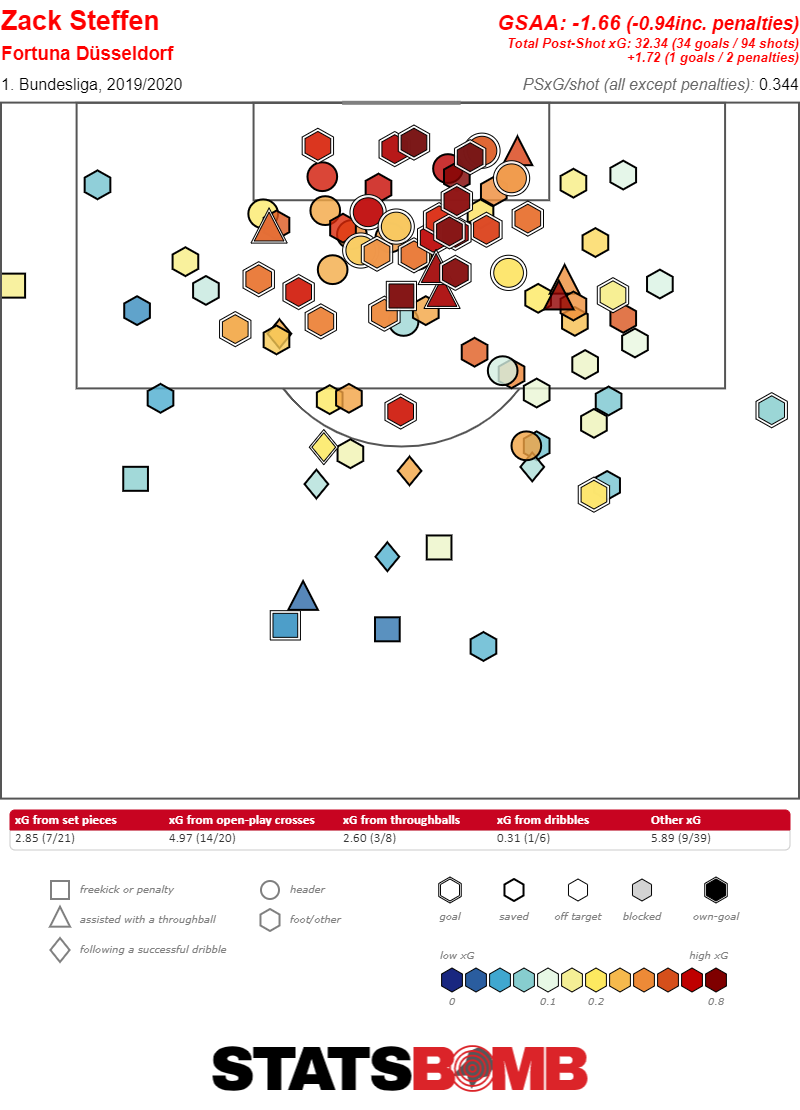 His distribution fills a huge need for Fortuna, who struggled mightily with Michael Rensing (also -8.4 under his xG against) on “launches”, passes over 40 yards, at just 40%. Because Fortuna, having lost Dodi Lukebakio and Benito Raman, are now a worse version of their deep-sitting, counter-attacking side, upgrading to the 47.7% of Steffen's launches is pretty valuable. That percentage is 6th in the league, close to a host of others just below 50%, with Manuel Neuer’s otherworldly 64.4% leading the pack.
His distribution fills a huge need for Fortuna, who struggled mightily with Michael Rensing (also -8.4 under his xG against) on “launches”, passes over 40 yards, at just 40%. Because Fortuna, having lost Dodi Lukebakio and Benito Raman, are now a worse version of their deep-sitting, counter-attacking side, upgrading to the 47.7% of Steffen's launches is pretty valuable. That percentage is 6th in the league, close to a host of others just below 50%, with Manuel Neuer’s otherworldly 64.4% leading the pack. 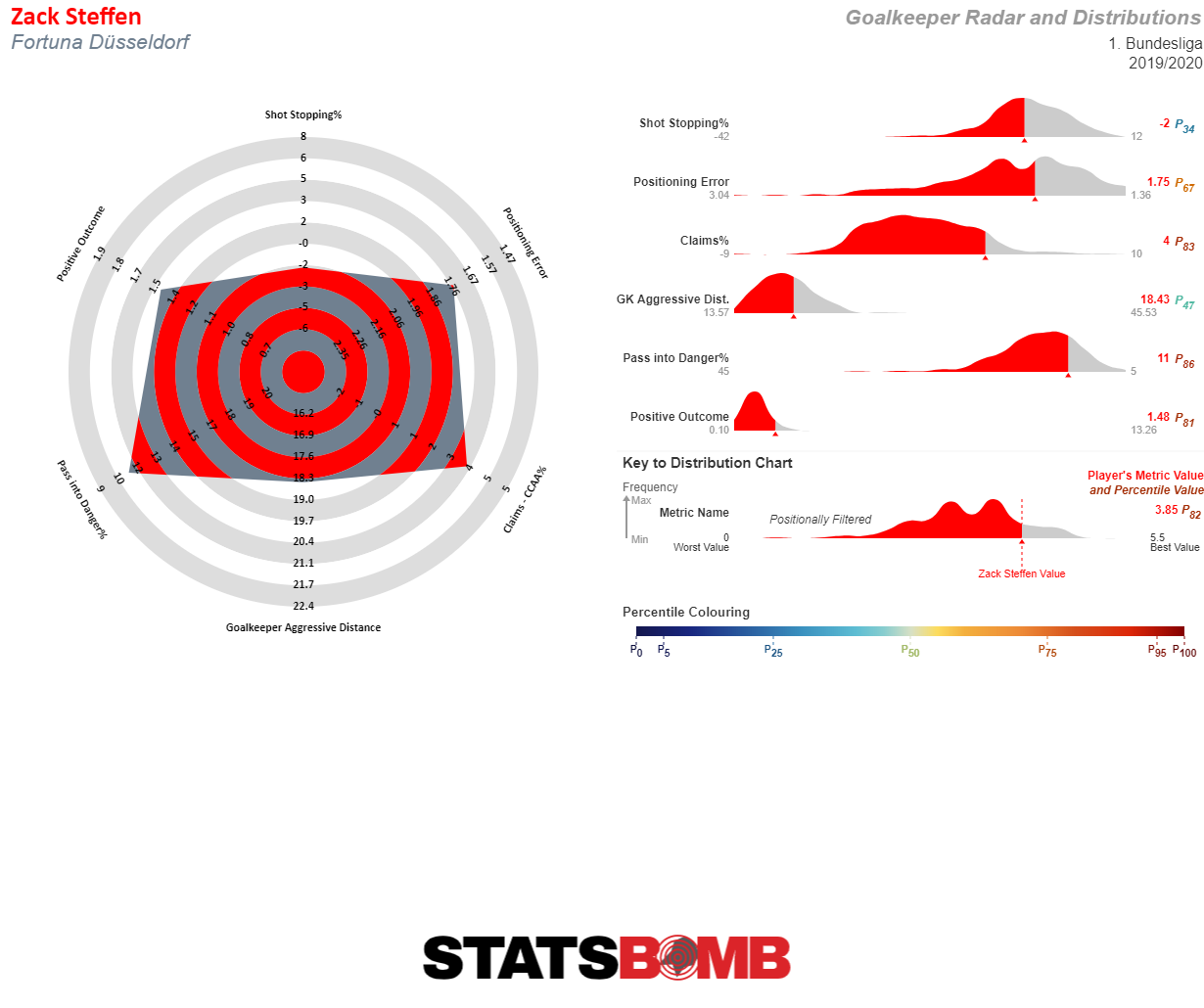 His other metrics, including claims and positional errors, are solid, while his comfort on the ball and willingness to pass into dangerous zones, makes his ceiling quite high. Overall, after a failed stint at Freiburg’s U23 a few years ago and a few USL minutes, it’s fun to see Steffen reaching his potential. We have to agree with sporting director Lutz Pfannenstiel — a man who played in goal on six continents should know, after all — that Steffen can be a top keeper at the European level.
His other metrics, including claims and positional errors, are solid, while his comfort on the ball and willingness to pass into dangerous zones, makes his ceiling quite high. Overall, after a failed stint at Freiburg’s U23 a few years ago and a few USL minutes, it’s fun to see Steffen reaching his potential. We have to agree with sporting director Lutz Pfannenstiel — a man who played in goal on six continents should know, after all — that Steffen can be a top keeper at the European level.
Tyler Adams
Moving into the defence/midfield we have RB Leipzig’s Tyler Adams, whose exact position is a source of great debate that has extended beyond USMNT supporters. Having made the move from New York Red Bulls to Leipzig a year ago, the 20-year-old shocked many by adapting so quickly to the switch from MLS to the Bundesliga. Adams had a string of impressive performances last spring in a defensive midfielder role until nagging adductor problems in April cost him much of 2019. 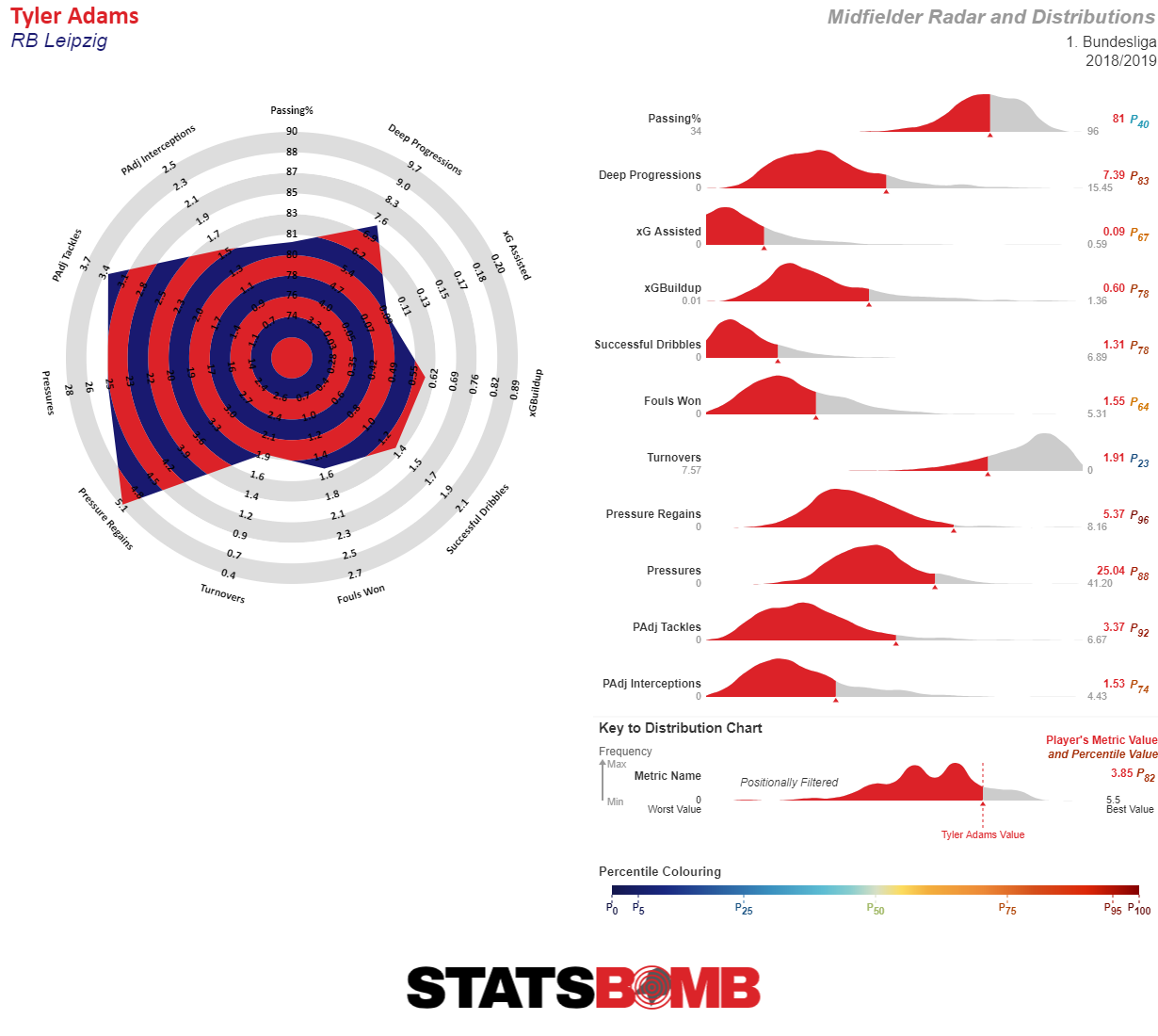 He made his return as against Augsburg in December and has since split his time at RB\RWB (even switching mid-game, like he did recently against Borussia Mönchengladbach) and defensive midfield. As a midfielder, he is a solid but somewhat unspectacular passer, who for the most part is good at maintaining and circulating possession and can progress the ball. He’s a decent but infrequent dribbler, doing so mostly to get out of pressure, although he's capable of the odd error such as the one prior to Union Berlin’s goal on matchday 18. Ranking in the 23rd percentile of turnovers with 1.91 per 90 minutes last year could become an issue down the road, though at Leipzig he’s at least protected by the out of possession-pressing madman, Konrad Laimer. Adams’ offensive contributions happen mostly in the buildup and more importantly when pressing, which is perhaps his best — but also his least obvious — skill. He has huge range, as seen in the recent Gladbach match where he was often tasked with pressuring the opposing defensive midfielder close to the box, amazing pressure regain numbers and very strong tackling metrics. He is just active.
He made his return as against Augsburg in December and has since split his time at RB\RWB (even switching mid-game, like he did recently against Borussia Mönchengladbach) and defensive midfield. As a midfielder, he is a solid but somewhat unspectacular passer, who for the most part is good at maintaining and circulating possession and can progress the ball. He’s a decent but infrequent dribbler, doing so mostly to get out of pressure, although he's capable of the odd error such as the one prior to Union Berlin’s goal on matchday 18. Ranking in the 23rd percentile of turnovers with 1.91 per 90 minutes last year could become an issue down the road, though at Leipzig he’s at least protected by the out of possession-pressing madman, Konrad Laimer. Adams’ offensive contributions happen mostly in the buildup and more importantly when pressing, which is perhaps his best — but also his least obvious — skill. He has huge range, as seen in the recent Gladbach match where he was often tasked with pressuring the opposing defensive midfielder close to the box, amazing pressure regain numbers and very strong tackling metrics. He is just active. 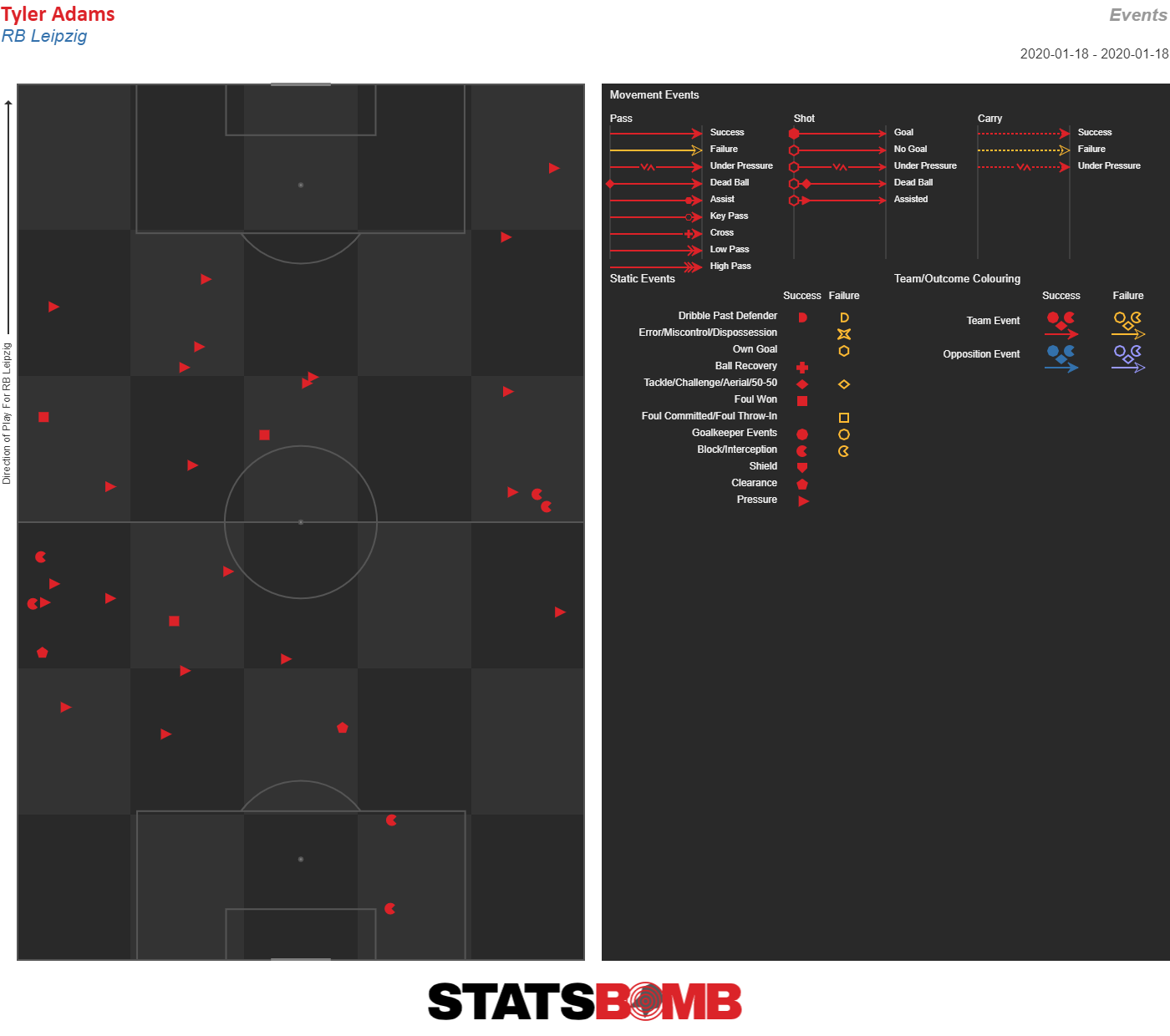 That explains why Nagelsmann uses him at right back, although the trickle-down effects of their centre back injuries — causing right backs Klostermann and Mukiele to have to play in the centre — obviously has quite a bit to do with that.
That explains why Nagelsmann uses him at right back, although the trickle-down effects of their centre back injuries — causing right backs Klostermann and Mukiele to have to play in the centre — obviously has quite a bit to do with that. 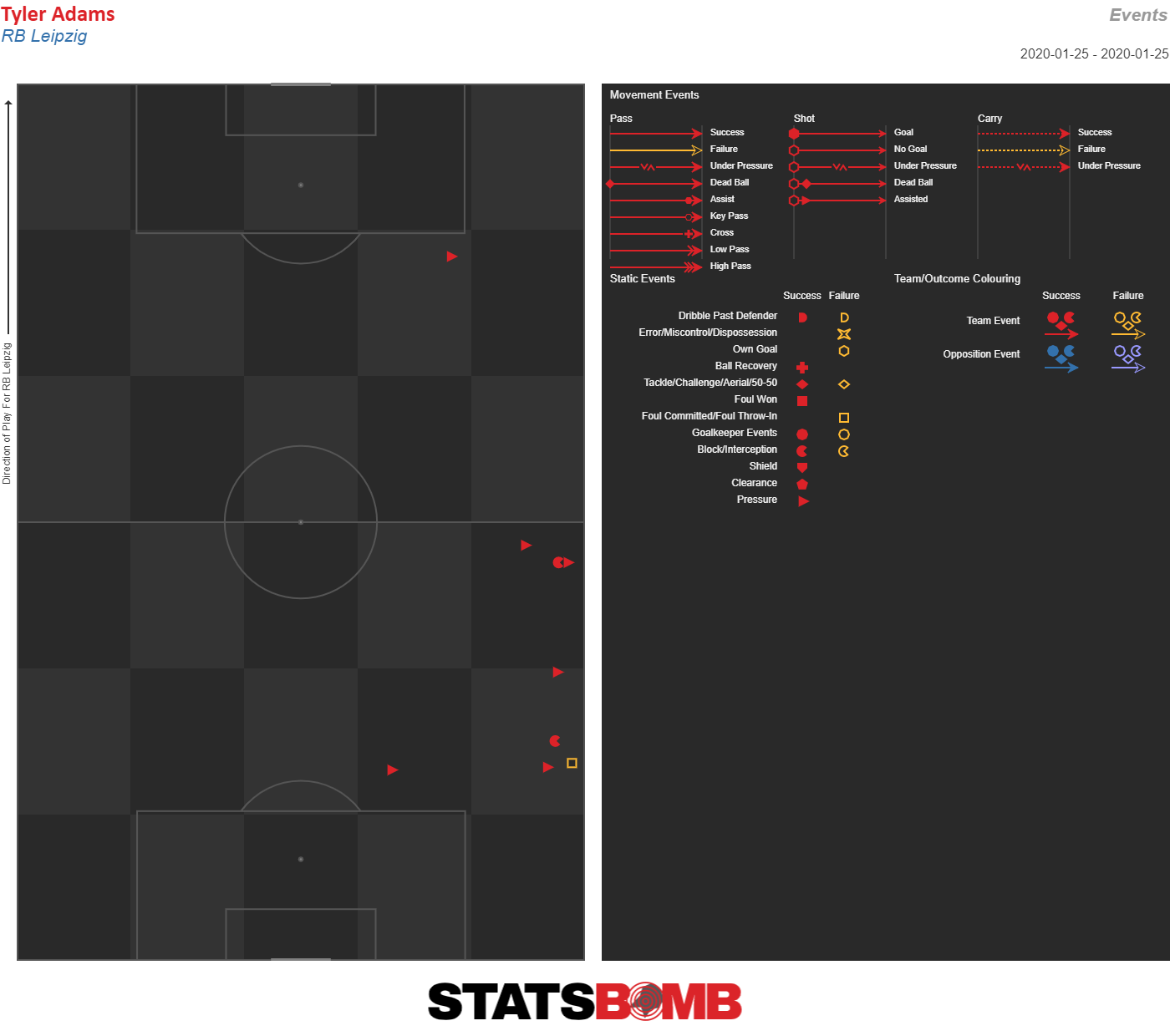 But as seen in his defensive activity map, his skills are perhaps not optimized out wide. At the Bundesliga level, he’s a fine option at fullback/wingback against the more limited sides. Still, Adams can struggle against physical types like Filip Kostić, which to be fair most people also do. His lack of 1v1 skills and elite athleticism are also much more obvious out wide, but he possesses the requisite game intelligence and combination play to do a good enough job, depending on matchups. Still, let’s not forget, Adams is doing all of this at an age where he’s still gotta wait ‘til Valentine’s Day to drink legally in the United States. The fact that Nagelsmann and Leipzig were content letting their vice captain and long-time servant Diego Demme go to Napoli amidst a title run, speaks volumes of the faith they have in Adams. Despite Leipzig’s slight difficulties showing this spring, Adams’ future continues to be bright. If he can solidify his spot for the rest of the spring, showcase himself in the Champions League he might not need to add another solid year next season to go onto something even bigger. Of course, there’s still three chances for him and Leipzig to win some silverware, so let’s not get ahead of ourselves….
But as seen in his defensive activity map, his skills are perhaps not optimized out wide. At the Bundesliga level, he’s a fine option at fullback/wingback against the more limited sides. Still, Adams can struggle against physical types like Filip Kostić, which to be fair most people also do. His lack of 1v1 skills and elite athleticism are also much more obvious out wide, but he possesses the requisite game intelligence and combination play to do a good enough job, depending on matchups. Still, let’s not forget, Adams is doing all of this at an age where he’s still gotta wait ‘til Valentine’s Day to drink legally in the United States. The fact that Nagelsmann and Leipzig were content letting their vice captain and long-time servant Diego Demme go to Napoli amidst a title run, speaks volumes of the faith they have in Adams. Despite Leipzig’s slight difficulties showing this spring, Adams’ future continues to be bright. If he can solidify his spot for the rest of the spring, showcase himself in the Champions League he might not need to add another solid year next season to go onto something even bigger. Of course, there’s still three chances for him and Leipzig to win some silverware, so let’s not get ahead of ourselves….
Giovanni Reyna
Speaking of not getting ahead ourselves, meet Gio Reyna, son of USMNT legend Claudio Reyna, himself with some Bundesliga pedigree with Bayer Leverkusen. Like Tyler Adams, Gio Reyna is another NY area product, who somehow was born in November of 2002. It's possible of course you were already introduced during Dortmud's cup match this week when he scored an absolute screamer of a goal in a losing effort against Werder Bremen Before he loudly announced himself on the scene, however, Reyna stole the show at Dortmund’s Marbella training camp this winter and Lucien Favre is smitten by the 17-year-old. First, he got called up to the first team squad in December, but did not take part in the 5-0 over Düsseldorf. Then in January, Reyna was promoted from the U19s to a full-fledged first team regular, and since then he’s been subbed on in all three of Dortmund’s dominant 5-goal drubbings, accounting for 32 minutes. So he’s been flying under the radar, because apparently there’s some Norwegian teenager stealing the headlines from him and Jadon Sancho’s monster season….. Understandably there is extremely limited data on his game - we’re actually going with NO RADARS on this one, but there are 11 matches at BVB U19s with 4 goals and 7 assists and 4 goals and an assist in four UEFA Youth League vs the likes of Barcelona and Inter. What we can show you is literally every single touch he's had in the Bundesliga so far this season. 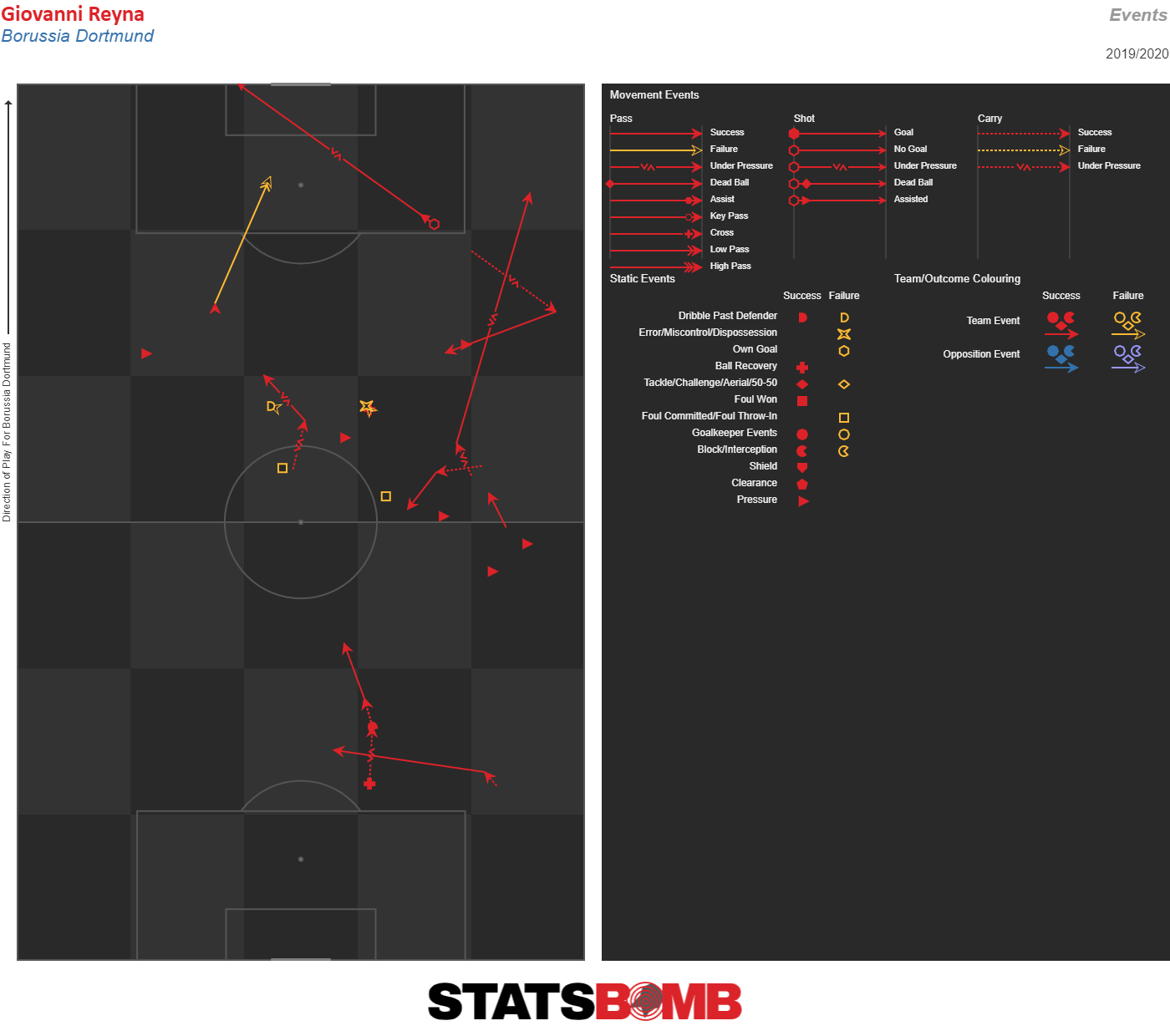 From the limited footage on video sites there are a couple takeaways: his size allows him to play as a winger, but also as an attacking midfielder. Maybe he can play as an out and out striker, though the less said about the US U17’s disastrous WC last fall, the better. Typically, Reyna receives passes with open body position, has exceptional technique and possesses quick speed of thought with good recognition of when to pass and when to dribble. His tactical understanding is mature for his age, occupying the right zones and positions and releasing teammates into space with quick, precise passes. In addition, he has shown abilities to be a composed finisher in preseason, and as the second option off the BVB bench, with his first first team goal already under his belt, his first Bundesliga goal can’t be far behind. It’s extremely difficult to project his career path - young wingers who arrive from Dortmund can skyrocket like Jadon Sancho or disappear into the abyss like Emre Mor - bonus points if you know where he moved this winter. Still, playing in Europe’s most goal-laden league and for a team that for the next few months might again (sorry Thomas Tuchel) have the world’s most exciting teen footballing duo (Sancho and Haaland), is just about the perfect opportunity. There’s even a certain Chelsea-based American he can ask for the blueprint….
From the limited footage on video sites there are a couple takeaways: his size allows him to play as a winger, but also as an attacking midfielder. Maybe he can play as an out and out striker, though the less said about the US U17’s disastrous WC last fall, the better. Typically, Reyna receives passes with open body position, has exceptional technique and possesses quick speed of thought with good recognition of when to pass and when to dribble. His tactical understanding is mature for his age, occupying the right zones and positions and releasing teammates into space with quick, precise passes. In addition, he has shown abilities to be a composed finisher in preseason, and as the second option off the BVB bench, with his first first team goal already under his belt, his first Bundesliga goal can’t be far behind. It’s extremely difficult to project his career path - young wingers who arrive from Dortmund can skyrocket like Jadon Sancho or disappear into the abyss like Emre Mor - bonus points if you know where he moved this winter. Still, playing in Europe’s most goal-laden league and for a team that for the next few months might again (sorry Thomas Tuchel) have the world’s most exciting teen footballing duo (Sancho and Haaland), is just about the perfect opportunity. There’s even a certain Chelsea-based American he can ask for the blueprint….
Josh Sargent
While the other players discussed have shown clear signs of promise, the signals on Sargent are more mixed, possibly due to the fact that he's with a struggling Werder Bremen side. The goodish news is that he does have two goals from two expected, with a sublime, juggling-dinking chip against Augsburg. Furthermore, Sargent’s shots are from good locations and after dribbles, or through balls, which is pretty good for an effective poacher. 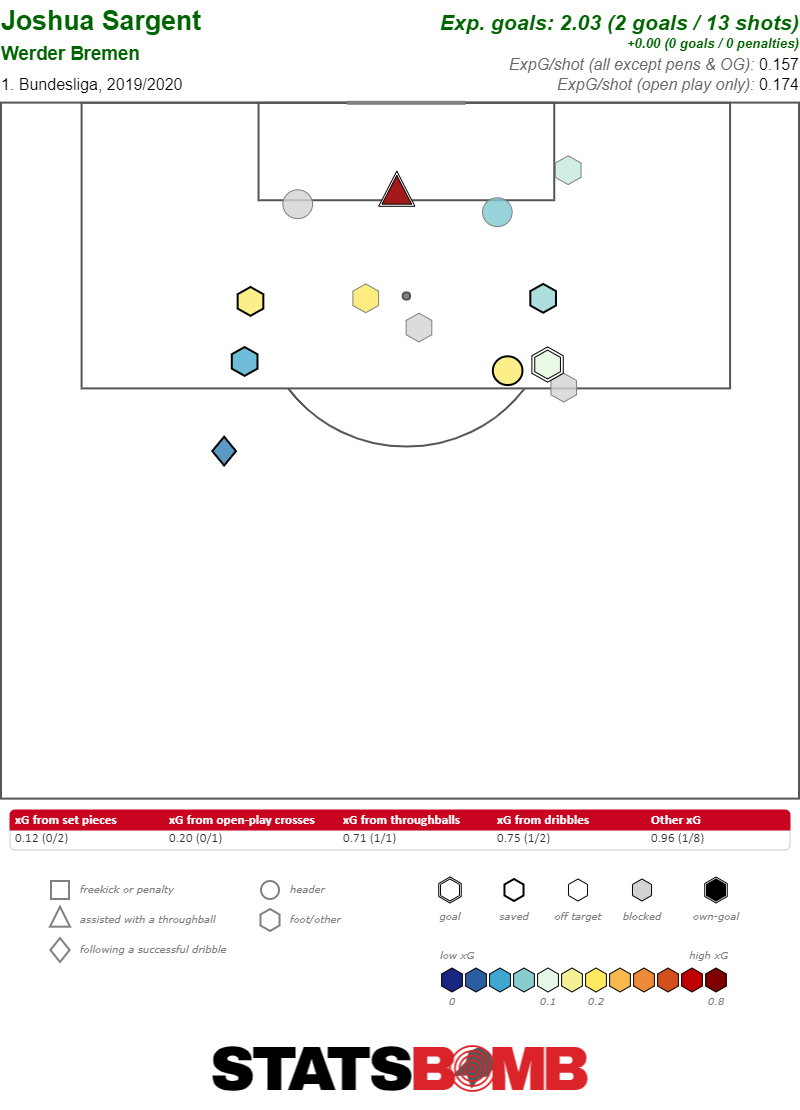 Unfortunately, that’s where the positives end so far. While it’s hard to separate his season from the dreadful campaign Werder is having, it’s just not been great. On a related note, who doesn’t miss Max Kruse, last seen trying to win the Turkish version of the Voice? Below you can see the number of open play completions to Sargent in the box by his teammates for this season: a few through balls that he runs onto inside the box, nothing on the left side and a couple down the right.
Unfortunately, that’s where the positives end so far. While it’s hard to separate his season from the dreadful campaign Werder is having, it’s just not been great. On a related note, who doesn’t miss Max Kruse, last seen trying to win the Turkish version of the Voice? Below you can see the number of open play completions to Sargent in the box by his teammates for this season: a few through balls that he runs onto inside the box, nothing on the left side and a couple down the right. 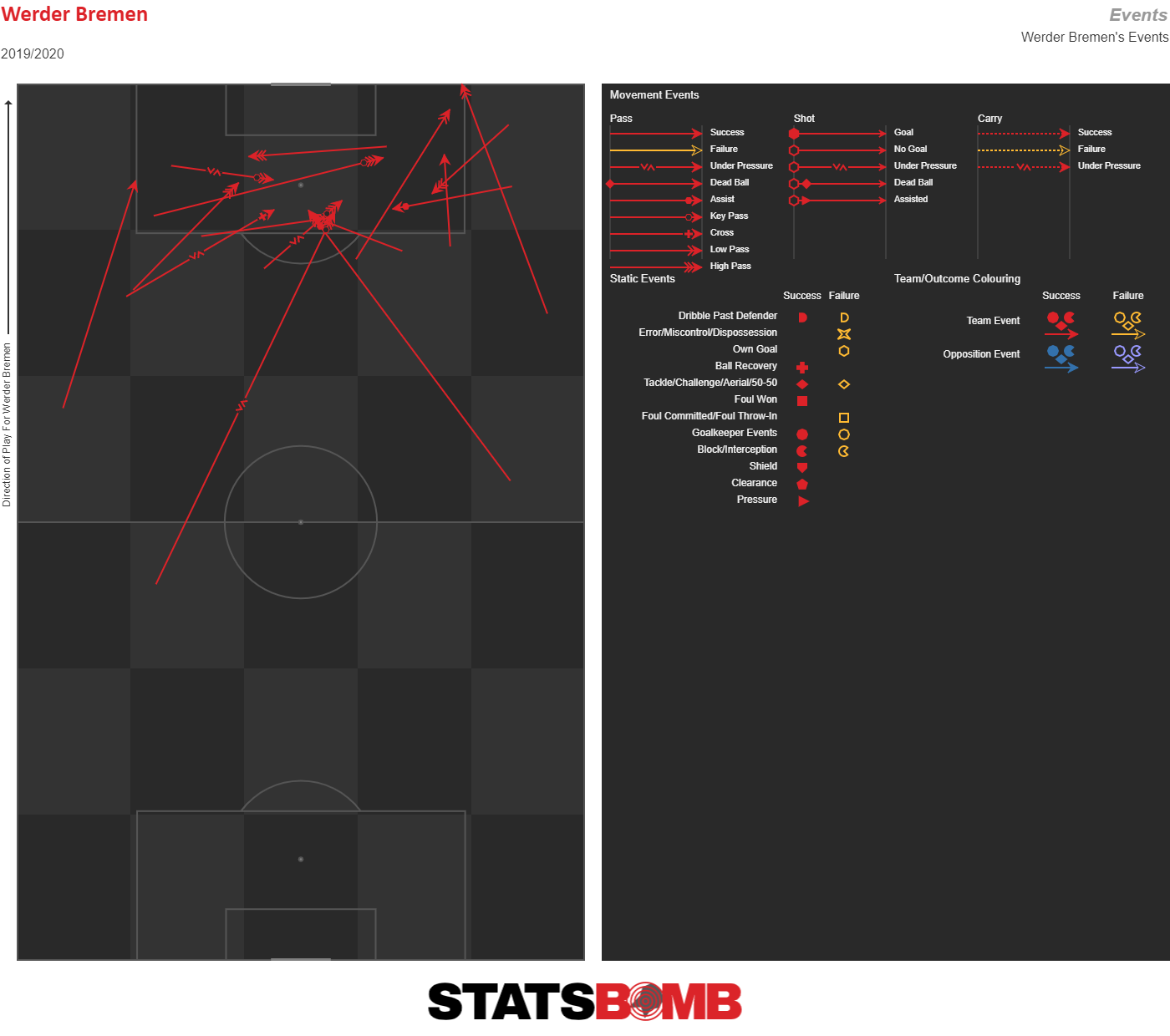 What’s interesting is the extremely few long passes that made their ways to Sargent, though as we see below, it’s not been for a lack of trying.
What’s interesting is the extremely few long passes that made their ways to Sargent, though as we see below, it’s not been for a lack of trying. 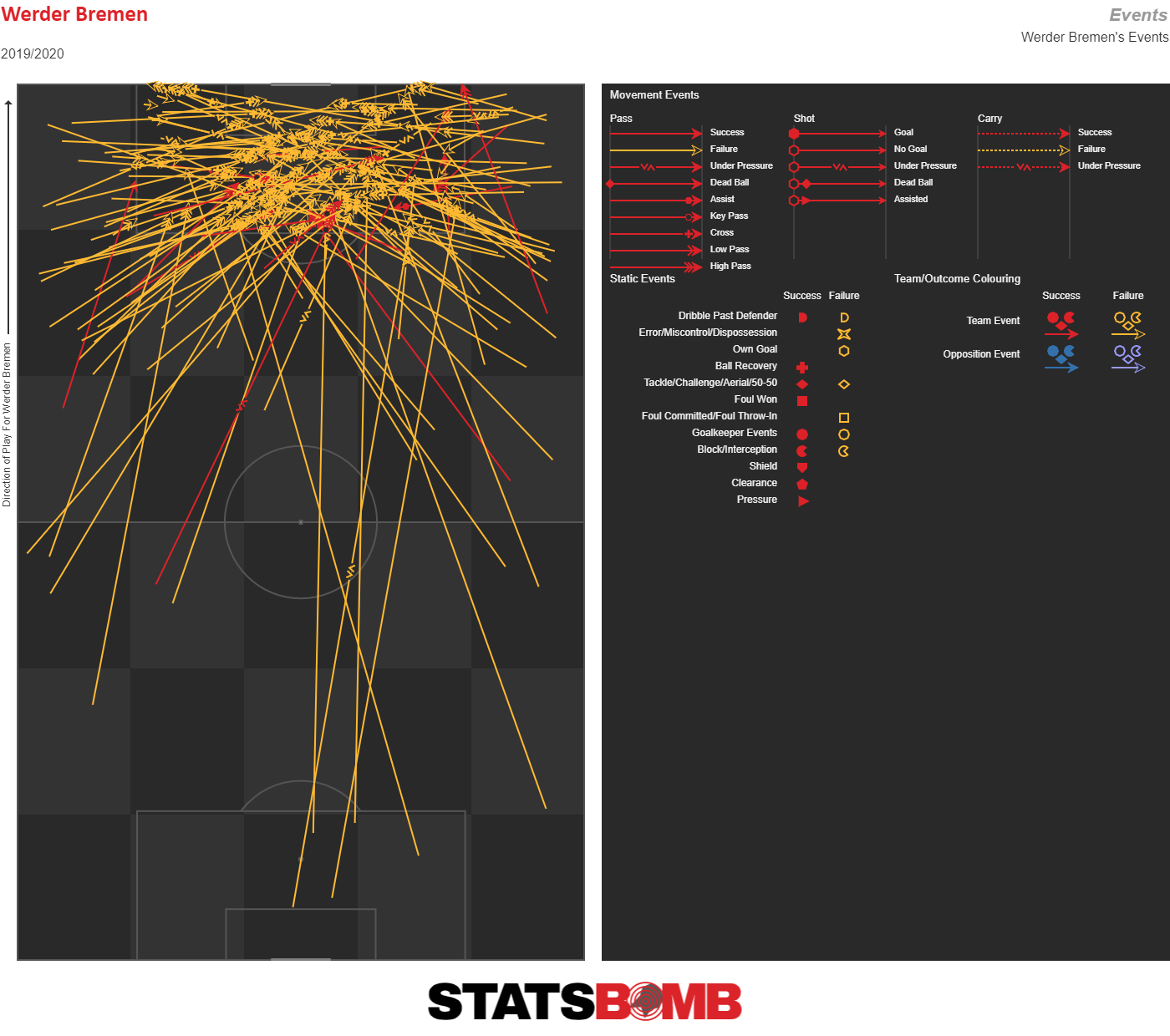 That’s a lot of yellow for a team like Werder whose progressive coach prioritizes possession. With a number of outstanding playmaking CBs/DMs (Sahin, Moisander and now Kevin Vogt, with Toprak and Veljkovic all in the solid category), you begin to suspect that some of the onus has been on Sargent. The most common criticism from fans, beat writers and commentators alike has been his difficulties in generating a shot on his own, an inability to hold on to the ball and struggles with his first touch and lay-off passes. From the data, the biggest issue with him is not his defensive effort, pressing or workrate which Kohfeldt has praised, but the lack of typical forward output: in the eight 90s he has logged, he takes just 1.56 per 90 and although he has 2 assists it’s on 0.03 expected goals assisted. He isn’t a dribbler, with 0.84 successful attempts per 90. And as you can see above, he’s often a poor/infrequent box presence. After a muscle injury in December, he started in Werder’s first two Rückrunde games, but his days as a sort of starter are coming to an end since on deadline day, Bremen brought Davie Selke back from Hertha. What the future holds for Sargent is very much contingent on Werder’s season unfolding, but ironically, as cruel as it may sound, a relegation personally might not be the worst idea for his development….
That’s a lot of yellow for a team like Werder whose progressive coach prioritizes possession. With a number of outstanding playmaking CBs/DMs (Sahin, Moisander and now Kevin Vogt, with Toprak and Veljkovic all in the solid category), you begin to suspect that some of the onus has been on Sargent. The most common criticism from fans, beat writers and commentators alike has been his difficulties in generating a shot on his own, an inability to hold on to the ball and struggles with his first touch and lay-off passes. From the data, the biggest issue with him is not his defensive effort, pressing or workrate which Kohfeldt has praised, but the lack of typical forward output: in the eight 90s he has logged, he takes just 1.56 per 90 and although he has 2 assists it’s on 0.03 expected goals assisted. He isn’t a dribbler, with 0.84 successful attempts per 90. And as you can see above, he’s often a poor/infrequent box presence. After a muscle injury in December, he started in Werder’s first two Rückrunde games, but his days as a sort of starter are coming to an end since on deadline day, Bremen brought Davie Selke back from Hertha. What the future holds for Sargent is very much contingent on Werder’s season unfolding, but ironically, as cruel as it may sound, a relegation personally might not be the worst idea for his development….